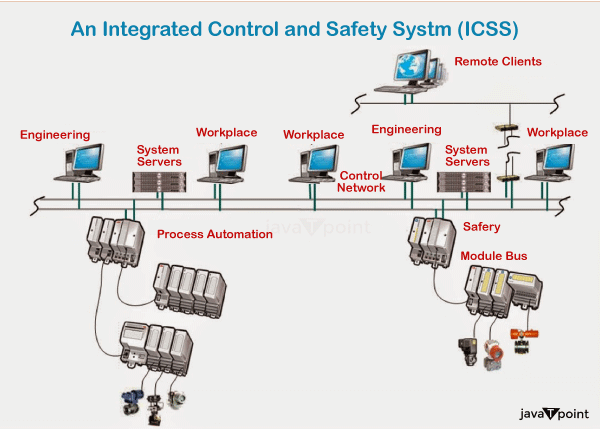What is the full form of ICSSICSS: Integrated Control and Safety SystemICSS stands for Integrated Control and Safety System. The use of Floating Production Storage and Offloading Vessels (FPSO), Central Processing Platforms (CPP), and Wellhead Platforms (WHP) at hitherto unexplored oil field areas with enormous sea depths has increased over the past ten years. In order to maintain effective oil production and to protect the safety of the environment and the crew, these boats are outfitted with a Central Control Room (CCR), which is in charge of carefully monitoring and controlling daily activities. The Process Control System (PCS), Safety Instrumented System (SIS), Fire & Gas Detection System (FGS), and High Integrity Pressure Protection System (HIPPS) are some of the various components that make up the Integrated Control and Safety System (ICSS), which is at the center of the CCR. 
Central Control Room (CCR) Real-Time Information & ControlOperator Control Stations with ergonomic designs in the Central Control Room give operators a thorough view of the manufacturing process. Visual representations, alarm logs, and historical archives are used to closely monitor any process disturbances. In the event of a process upset, operators have immediate access to the data they need to take the appropriate corrective action and return the process to normal functioning. As a safety measure, the highly integrated Safety Instrumented System (SIS) immediately shuts down impacted process units to stop upsets brought on by equipment failure, changes in process parameters, or human error from worsening. Key Functions and StrategiesThe Process Control System's (PCS) ability to adopt effective control methods is crucial to the plant's efficient operation. Some solutions include managing start-up permissive and bypass, sequence control, correct tuning of PID control loops, and interlocking. In addition, the PCS is essential for recording tasks, including event sequencing, historical archiving, and alarm management. The Fire and Gas System (FGS) quickly recognizes emergencies like hydrocarbon gas leaks, smoke or fire outbreaks and starts protective measures like sounding fire alarms, turning on fire beacons, providing area indications, and sending cascading signals to the SIS for shutting down affected units. Key Advantages and HighlightsA variety of advantages and features make the Excel Marco ICSS an effective and dependable system. The PCS, SIS, and FGS are all fully integrated, which encourages efficient coordination and control amongst the subsystems. Its user-friendly human-machine interface guarantees operator comfort, and the specific software library enables the development of specialized solutions based on industry standards. The system's operators are able to quickly make educated judgments thanks to its real-time data collecting and presentation capabilities. Additionally, the ICSS has Functionally Separated Safety Systems that have been TUV-approved to SIL3, guaranteeing high performance and safety. Lastly, it is a cost-effective option for offshore oil production vessels due to its optimized performance-to-cost ratio. Benefits and Emergency Shutdown HierarchyICSS offers important advantages for managing emergency shutdowns. Through resource sharing, which involves the sharing of the Engineering Station (ES), PLC, Operator Station Client (OS Client), Operator Station (OS Server), and Historian among various components, the system's operational and financial efficiency is increased. The ICSS smoothly integrates process and safety, enabling standard and safety programs to run in separate areas of the same CPU. A specialized software library created based on industry standards facilitates this customization. Additionally, the removal of communication gateways lowers the likelihood of failure sites, improving overall safety and reliability. System Architecture and Time SynchronizationThe Central Archive Server (CAS), Automation Station (AS), Operator Station Client (OS Client), Redundant Operator Station Server (OS Server), and Third-Party OPC Server make up the ICSS's architecture. Industrial Ethernet is used to create a redundant ring network that facilitates communication between various components. PROFIBUS DP with PROFI-safe safety profile, which permits communication between the safety program & fail-safe inputs/outputs without needing additional hardware, ensures a secure connection. Important data, such as alarm messages, process values, reports, and batch data, are kept on the Central Archive Server and can be exported for additional data analysis or studied in trend view at client stations. The GPS Clock or Server PC Clock can be used as the Time Master to synchronize the time, giving high resolution and precision to enable effective plant operation. High Integrity Pressure Protection System (HIPPS)In order to prevent the over-pressurization of a plant, especially in the production header of FPSOs, HIPPS is a crucial feature of ICSS. It functions in Zone 2 environments and adds another layer of security to the production process, improving its overall security and dependability.
Next Topicfull-form
|
 For Videos Join Our Youtube Channel: Join Now
For Videos Join Our Youtube Channel: Join Now
Feedback
- Send your Feedback to [email protected]
Help Others, Please Share










